Introduction
Why can such an easy task as switching to a natural deodorant be so tricky?

More and more people are switching to natural deodorants because they want to ditch unnecessary chemicals in conventional deodorants.
However, they seem to STRUGGLE with making the switch to a natural deodorant.
I know for sure my husband and I did.
Frequent complaints sound like “I stink something fierce under there when I try to make the switch”, or, “I’ve spent a fortune on natural deodorant and, nothing seems to work for me”. “Natural deodorants are not for me; I’m used to clinical strength deodorants”.
Besides, there seems to be a lot of confusion about which ingredients are good and which are not.
This guide intends to make the switch to a natural deodorant simpler, to give actionable information, and to troubleshoot the journey.
However, if you are already experiencing issues with switching to a natural deodorant, you may want to jump right down to the tips and tricks section.
If you have given up on your journey – PLEASE READ THE TIPS AND TRICKS BELOW AND TRY AGAIN!
I first started on this journey (Yes, switching from a conventional to a natural deodorant is a journey…) about five years ago.
The reason was that I did not tolerate the chemicals or smells in conventional deodorants because of multiple chemical sensitivities I had at the time.
Since I wasn’t sure which natural deodorant to try, and which ones I would tolerate, I went all hippie and ditched my deodorant completely!
It was not the best idea I’ve had…
In a few words, I stank!

Why do we sweat?
Sweating is very natural and essential for preventing the human body from becoming overheated.
In short, the human body has two types of sweat glands, eccrine and, apocrine.
Eccrine sweat glands are located throughout the body with the largest concentration on the soles of the feet and palms of the hands.
Their job mainly is to regulate body temperature and act as thermoregulatory devices. The glands can produce at least 500mL to 750mL in a day. [1]
Apocrine sweat glands are located in the armpits, and in the genital region. They start to function at puberty under the stimulation of sex hormones.
Their job is to continuously secrete viscous, protein-rich product into the hair follicles and gets expelled from there to the skin odorless.
Natural deodorant stinkiness and microbiome talk
When the odorless sweat gets to the skin and is exposed to bacteria, it usually develops an odor. [1]
What causes more body odor in the underarm compared to other places in the body is that it is a perfect place for the gathering of bacteria, it is moist, and warm [2]
To get nerdier here, it is mainly the odor-causing bacteria, Corynebacteria, and Staphylococcus that dominate the underarm bacterial flora. [3]
When I was reviewing and reading a lot of scientific articles for this guide, it surprised me how intensive the research on underarm sweat has been over the last years.
The cosmetic industry has mostly driven this interest. They want to be very specific in how they design the deodorants to target the sweat mechanism, by either blocking the sweat and how they eliminate the odor.
As you have probably noticed, there is a lot of hype around our microbiome, especially in the gut. We also have skin microbiome which has not been studied much as much.
Recent articles have focused on the microbiome on the skin. The focus has been on measuring how products, like deodorants, influence the microbial communities living in our underarms. [4]
The studies have shown that modifying how people take care of their hygiene (like using soap, and deodorants), it can alter the skin microbiome. [4,5]
Additionally, they show that the bacteria seem to be age, gender, and race dependent. But there is still some time until we understand how exactly and what is good and what is bad.

Difference between antiperspirant and deodorant
Antiperspirants and deodorants are often confused.
The intention of an antiperspirant is like the name indicates. To stop the sweat from forming in the first place. For this purpose, the FDA classifies antiperspirants as drugs. Aluminum hydrochloride has commonly been used for this purpose.
Deodorant, on the other hand, is mainly designed to mask the underarm odor. It does to some extent, take care of the wetting too.
My personal experience with sweat and natural deodorants
From my own experience, I have noticed that body odor has a lot to do with hormones and my lifestyle.
When I was pregnant with my son, I was using a minimal amount of natural deodorant. It was obvious how suddenly the smell changed and there was a LOT of underarm smelling!
The same went on for the breastfeeding period. I’ve heard it from a lot of women around me as well.
When I don’t drink enough water, I get smellier…
Who hasn’t experienced stress sweat?!
When I eat something I don’t tolerate, I am more stinky…
During sweating in synthetic clothing, especially sports clothing…
When I drink a lot of coffee, I sweat more, and it doesn’t necessarily smell well…
I also noticed that when I am eating very clean, drinking plenty of water, regularly go to saunas, exercise, my sweat doesn’t smell at all.
Putting clay masks and ACV sprays on my underarms has also helped a lot, more on that later in this guide.
Label reading 101
The main reason people want to avoid conventional antiperspirants is that they want to ditch unnecessary chemicals. The purpose is often to reduce the chemical load on their body, or simply because they don’t tolerate them.
For instance, Aluminum Chlorohydrate is the chemical that has gotten the most attention in conventional antiperspirants.
Scientific articles have published some indications that excess aluminum use (like in antiperspirants) may be linked with breast cancer and Alzheimer’s [1,2,3,4]
However, no scientific proof backs this up. There are for sure some indications and theories but no causal relationship has been found.
The main reason I avoid Aluminum in my antiperspirants (apart from being on the safe side) is the intention to block the sweat ducts in the armpits, so the sweat doesn’t form.
To me, that is significantly interfering with my body’s natural purification system, and I don’t want that.
Besides, the interaction of sweat and aluminum compounds also tends to make yellow stains in clothing.
Other ingredients people, including me, want to avoid are talc, triclosan, propylene glycol, parabens, phthalates, alcohols, and artificial fragrance.
Some of these are irritants or allergens, and others have been linked with hormonal disruption and other ailments. [6,7,8,9]
Synthetic fragrance in natural deodorants
Let’s dive a bit deeper into the word and ingredient fragrance.
It matters if the word fragrance is in a product from Europe or the United States.
If it’s a product from the United States, there is a strange phenomenon going on…
To my understanding, there are trade secret laws that have a loophole that states that if you have a chemical that’s less than 1% percent concentration. You can literally put any ingredient in there and call it ‘fragrance’ or ‘parfum’.
According to Women’s Voices for the Earth: “Dozens – sometimes even hundreds – of chemicals can hide in beauty and personal care products that contain fragrance. Many of these fragrance chemicals are linked to harm to human health.”
In Europe, on the other hand, some regulations have banned around 1400 chemicals and request more detailed labeling than in the US.
If you are in doubt of the quality of the fragrance used as if essential oils are being used, companies are pretty proud of it so they usually state it on the ingredient label.
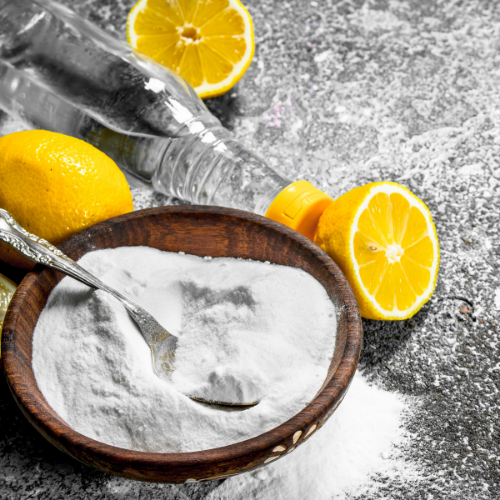
What to expect when switching to natural deodorant – Tips and Tricks
My journey (and my husbands) from ditching deodorants entirely, to tolerating several natural types of natural deodorants without issues has been bumpy.
Together we have probably experienced all the following issues that seem to be quite common:
- Getting extra sweaty first after we ditched the conventional deodorant
- Smelling
- Rashes
- Darkened skin in armpits
- Burning sensation
- Red skin
- Itchy skin
- Irritated skin
- Swollen lymph nodes and armpit pain
- Stain in clothes
- Natural deodorants being like sandpaper
- Natural deodorants being too powdery (for someone as clumsy as me, the white powder somehow ends up in my clothes or all over the floor… you should see my husband’s face – “Were you using that deodorant again?!”)🤣
- Natural deodorants being too pasty
Oh my, that’s a long list you may say. But don’t despair, we are all different, and many never experience any of the issues above.
Even though the journey of switching to a natural deodorant may be bumpy, I sincerely believe it is worth reducing the chemical load in our lives.
In this section, I want to troubleshoot the journey for you and give you all my tips and tricks, to make sure you don’t have to go through the pain.
Don’t forget, people experience many of these issues with conventional deodorants as well.
Rashes – Red skin – Burning sensation
From what I know, there can be a couple of reasons for natural deodorant rashes:
You may be reacting to the baking soda in the natural deodorant, which seems to be quite common and is even referred to as the baking soda burn.
There is possibly some pH imbalance because the baking soda is making the deodorant too alkaline for your personal pH.
This seems to vary between brands, and my understanding is that the natural deodorant ingredients need to be in pH balance.
Start with a natural deodorant that doesn’t list baking soda as an ingredient. The ones marked for sensitive are an excellent starting point. Some people have also used an apple cider vinegar toner before applying the deodorant with baking soda with success (see recipe below).
You are breaking out after ditching your conventional deodorant.
ACV spray and Clay masks helped me and my husband to get over this phase (see recipes below).
Coconut oil is not for everyone – my face burns if I apply coconut oil!
You may be experiencing an allergic reaction (several allergens can hide in natural deodorants, more on that below).
If you suspect an allergy, you should ditch the natural deodorant you are trying ultimately!
For sure I was reacting to the baking soda, to begin with, my armpits were burning!! My skin even flaked off at one point. I started with a natural deodorant for sensitive, and it worked out pretty well 🙂
Some people begin to experience this issue after weeks or months of tolerating it.
Darkened skin in armpits
My armpits got darker for some period. My solution was to ditch the baking soda and try a natural deodorant that was free from it. Others have also reported on leathery skin after baking soda use.
Try cutting down a lemon and apply it on your underarms to “brighten” the skin again. (make sure you are not exposed to the sun for too long – you may quickly get sunburned)

You may want to go a bit hippie (especially when you are at home) and give your pits a break for some time.
Try a natural deodorant that doesn’t have baking soda in it.
Swollen lymph nodes
My husband and I experienced this. I’m not sure why this happens, but I’ve read a lot of comments where this has also happened to people, more with some brands than others.
It has been my experience and others as well that this will go back to normal after discontinuation of use. Please advise with your doctor if this persists.
I have contacted some companies that sell natural deodorants asking if they know the reason for this, and have gotten no replies. I will update this post if I get answers.
Try a natural deodorant that doesn’t have baking soda in it.
Stain in clothes
Yes, the natural oils used in many natural deodorants can stain clothes, especially coconut oil. I have not experienced this much.
It’s good to be aware of this and make sure you don’t use too much, especially when you are wearing sensitive clothing. This issue seems to vary a lot between brands.
Natural deodorants stop working after some time
I have not experienced this issue but have heard about it from some people.
Try to rotate brands and apply the clay mask or ACV spray more frequently.
Make sure your deodorant is not expired because many natural deodorants have no preservatives and therefore will have a shorter shelf life.
Different forms and textures of natural deodorants
Like with conventional deodorants /antiperspirants the forms people prefer vary. Personally, I have tried natural deodorant sticks, pastes, creams, liquid roll-ons, crystals, and powders.
Some formulations I have tried have been to “rough,” almost like sandpaper, especially when I’m sensitive. If that’s the case for you, I would instead go for a more liquid or creamy type of deodorant.
Tip for hippie women and men: My husband is bushier in his underarms than me, and he complains about too pasty deodorants, that they stick too much to his hairs and almost don’t get to the skin, where they belong.
Extra tips for the switch to a natural deodorant
Drink enough water. It will help with reducing underarm odor.
Exfoliate your armpits. Like with your face, exfoliation of the armpits may help with reducing colonization of odor-causing bacteria. As a bonus may make your underarms more smooth.
Like with a conventional deodorant, don’t apply your natural deodorant right after shaving.
If your skin is sensitive, or if you are sensitive to fragrance, you may want to try a fragrance-free one.
Applying a little bit of jojoba in your underarms before you go to sleep may help with the transition.
Why people are putting face masks under their armpits
When I first ditched a conventional deodorant several years ago, I read that using a clay mask may help with the transition to a natural deodorant.
I gave it a try and experimented quite a bit with different recipes. The recipe below worked best, both for my husband and me. It made a massive difference for us and speeded up the process of reducing underarm odor.
Occasionally I react to baking soda for some time, and then I tolerate it again. As mentioned above, it has to do with the pH of the armpits because the baking soda makes the pits more alkaline.
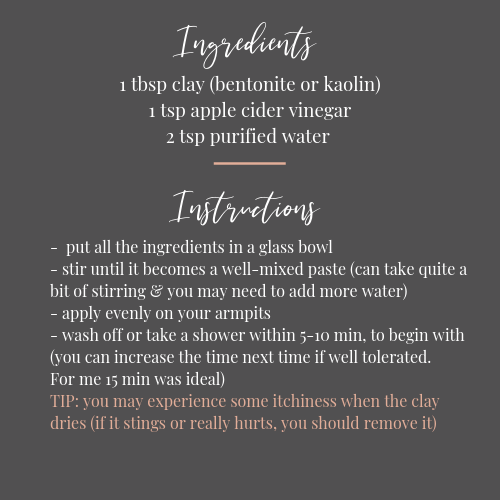
Apple Cider Vinegar (ACV) spray for speeding up the natural deodorant journey
If you have been reading blog posts about something health-related, the chances are that ACV (apple cider vinegar) has been mentioned.
The use of apple cider vinegar dates back to Hippocrates, as he reported using ACV and honey to fight infections and protect open wounds.
Apple cider vinegar in your hair, drinking apple cider vinegar, gargling apple cider vinegar, baking with apple cider vinegar, apple cider vinegar for cleaning, apple cider vinegar for sunburns…
Yes, I admit it, I have probably tried all of these things 🙂
I am a fan of apple cider vinegar for some specific situations, but in my opinion, this apple cider vinegar trend is going a bit overboard.
One of my favorite way of using an ACV is spraying it on my armpits. What is does is that it “helps restore and balance your skin’s pH levels, wipes out bacteria and dissolves dead skin cells,” according to Dr. Whitney Bowe, Board Certified Dermatologist.
If you are into DIY, I recommend you try the recipe below, it’s very straightforward. It worked very well for my husband and me.
I recommend using the clay mask before you take a shower and the ACV spray before you go to sleep.
No worries, the ACV smell will fade away quickly!
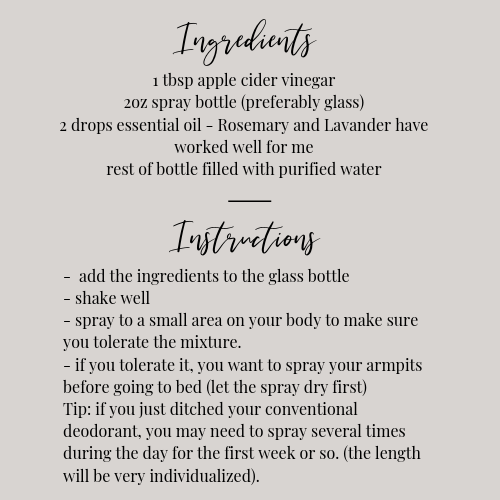
What is a natural deodorant anyway?
I have used the word natural deodorant way too many times in this blog post without actually defining what it is…
The unfortunate thing with the word natural is that it doesn’t have much of meaning these days.
FDA doesn’t even regulate the use of the word “natural.” All-natural doesn’t necessarily mean the product is natural. Sometimes the product has a couple of natural ingredients, along with several chemical-laden ones.
Green-washing is a word used for the practice of making misleading claims about how natural, green, or environmentally-friendly a product is. Companies use terms on their packaging, and in their advertising, like “healthy,” “green,” “eco-friendly.” without the products being so.
What is, however common to good natural brands is the fact they are using ingredients derived from nature. The ingredients are free from harsh chemicals like the ones mentioned above.
How does natural deodorant work?
Let’s get straight to the point here.
Roughly, natural deodorants consist of the following formula (usually one type of ingredient, but sometimes combined):
Moisture absorber
Starches like arrowroot, corn starch, potato flour, clay, zinc.
Odor absorbers or antibacterial ingredients
Baking soda, Coconut oil, citric acid, potassium alum*.
Protection and thickener
Almond wax, Beeswax, Candelilla vax.
Nice smell
Essential oils
Moisturizer
Coconut oil, jojoba oil, cypress oil, almond oil, shea butter, hemp seed oil, sunflower seed oil.
Are all natural ingredients good?
*Potassium alum
Potassium Alum or potassium aluminum sulfate to be exact is naturally occurring mineral and the main ingredient in natural deodorant crystals.
The main function, in deodorants, and antiperspirants, is to stop the growth of the odor-causing bacteria mentioned above.
I don’t want to ditch the use of potassium alum in natural deodorants, but I want to make sure that people switching from conventional deodorants because they contain aluminum, know that Potassium Alum contains aluminum.
This is what manufacturers of natural deodorant brands that use Potassium Alum in their products, like one manufacturer states on their website: “Alum has a long history of safe use as a deodorant ingredient and is a traditional alternative to many modern deodorants. Our deodorant Undercover agent is made from just a solid molded lump of crystallized alum, which is a naturally mined mineral salt.”
Natural Fragrances
Even though natural deodorants use natural fragrances, made from organic essential oils, they could still be troublesome.
Fragrances can potentially trigger allergic reactions, and so much that the Danish Environment Ministry and the EU have created a list of the 26 most common allergenic perfumes. [10]
Here is the full list of allergens if you are interested.
Are some chemicals safe?
If you look up chemical ingredients in EWG’s Skin Deep cosmetic database, they will rate the safety of the ingredients based on scientific research.
They will give the ingredient, and, or the product (if it is listed in their database) a two-part score – a hazard score and a data availability score.
An ingredient hazard score is a number from 1-10, and it reflects the known suspected hazards of the ingredients.
There are three types of hazard scores, green for low hazard, yellow for moderate hazard, and red for a high hazard.
The data availability rating has the following ratings: None, limited, fair, good, robust.
When something is made from chemicals, it means it is made within a controlled environment, and with a lot of regulations behind.
Even though many natural deodorant brands will have complicated ingredient labels with a lot of names you cannot even pronounce, it doesn’t necessarily mean that they have proven to be hazardous.
In the end, it is totally up to you to decide how natural you want to go, or if you are fine with mixing some chemicals with natural ingredients. My motto is to educate you so you can make informed decisions.
Homemade natural deodorant recipes
If you are in a DIY, experimental mood, you may want to try some simple, one-ingredients. Some people only use these and swear by it.
When using lemon or lime you want to make sure you are not exposed to the sun for too long – you may quickly get sunburned)
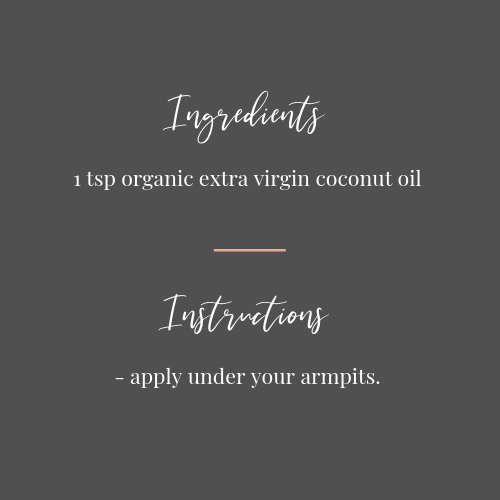
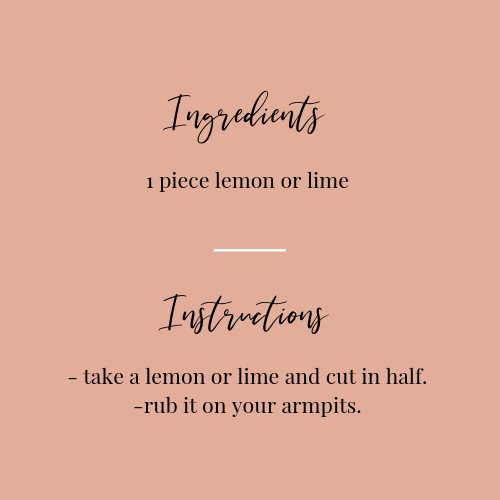
Conclusion
I really hope this guide made you realize that switching to a natural deodorant doesn’t happen overnight for most people.
While some of the tips don’t take a lot of effort, not implementing them might ruin your switch to a natural deodorant.
Don’t worry if you’ve already made some natural deodorant mistakes. You are not alone.
I want to encourage you to commit to getting started on this journey and implementing one tip today.
In the end, I am very curious to know: when it comes to switching to a natural deodorant, what is the single biggest challenge, frustration, or problem that you’ve been struggling with?
Yes, for most people. You may need to try some natural odor-reducing tactics like an armpit clay mask and ACV spray before switching. The baking soda used in many natural deodorants can cause trouble, like rashes, irritated skin, and darker underarms because of how it influences the armpit’s acidity level. You may want to start with a natural deodorant without baking soda or a sensitive formula.
Usually, it is the baking soda that causes rashes or irritated skin. It can also be an allergic rash.
The intention of an antiperspirant is like the name indicates. To stop the sweat from forming in the first place. For this purpose, the FDA classifies antiperspirants as drugs. Aluminum hydrochloride has commonly been used for this purpose.
Deodorant, on the other hand, is mainly designed to mask the underarm odor. It does to some extent, take care of the wetting too.
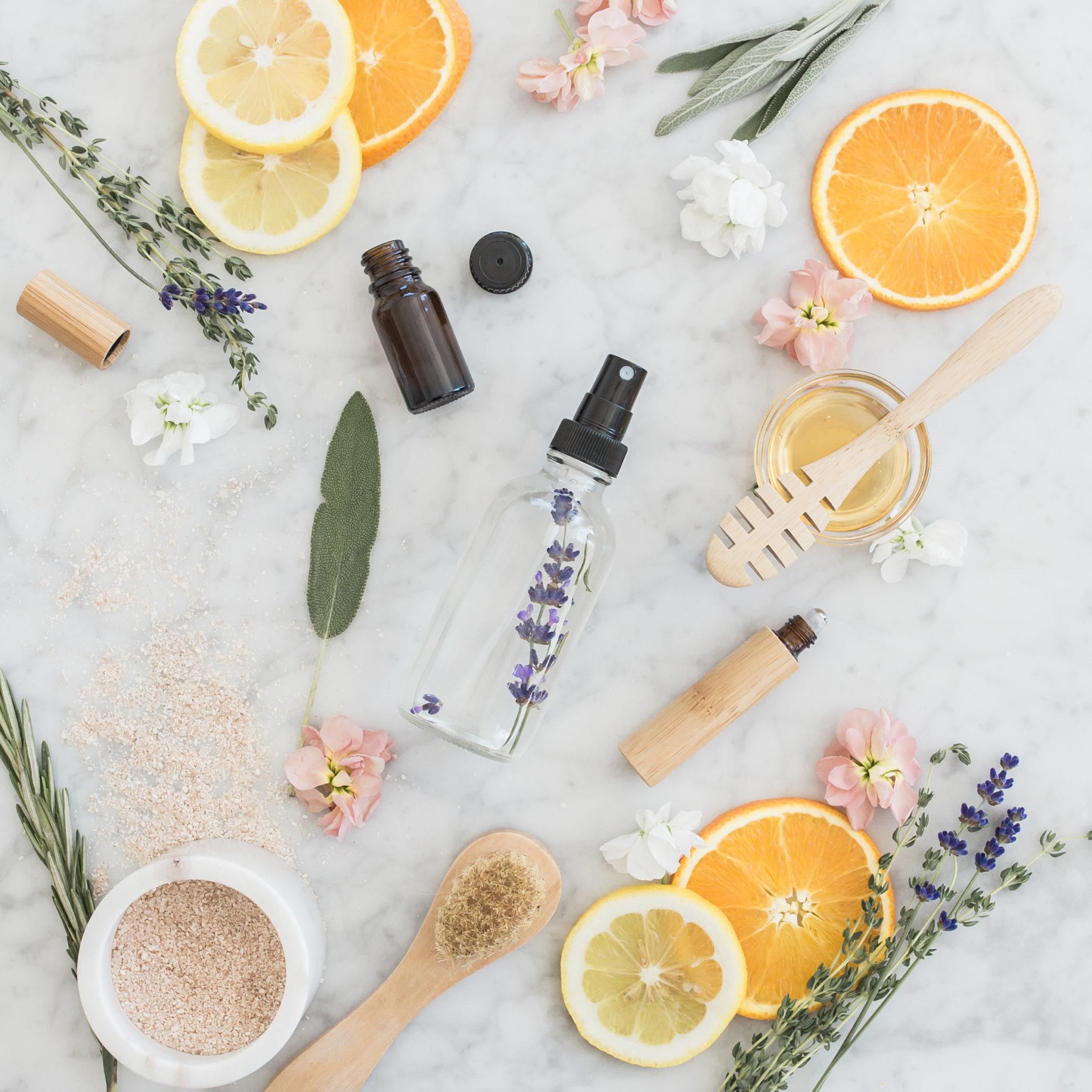
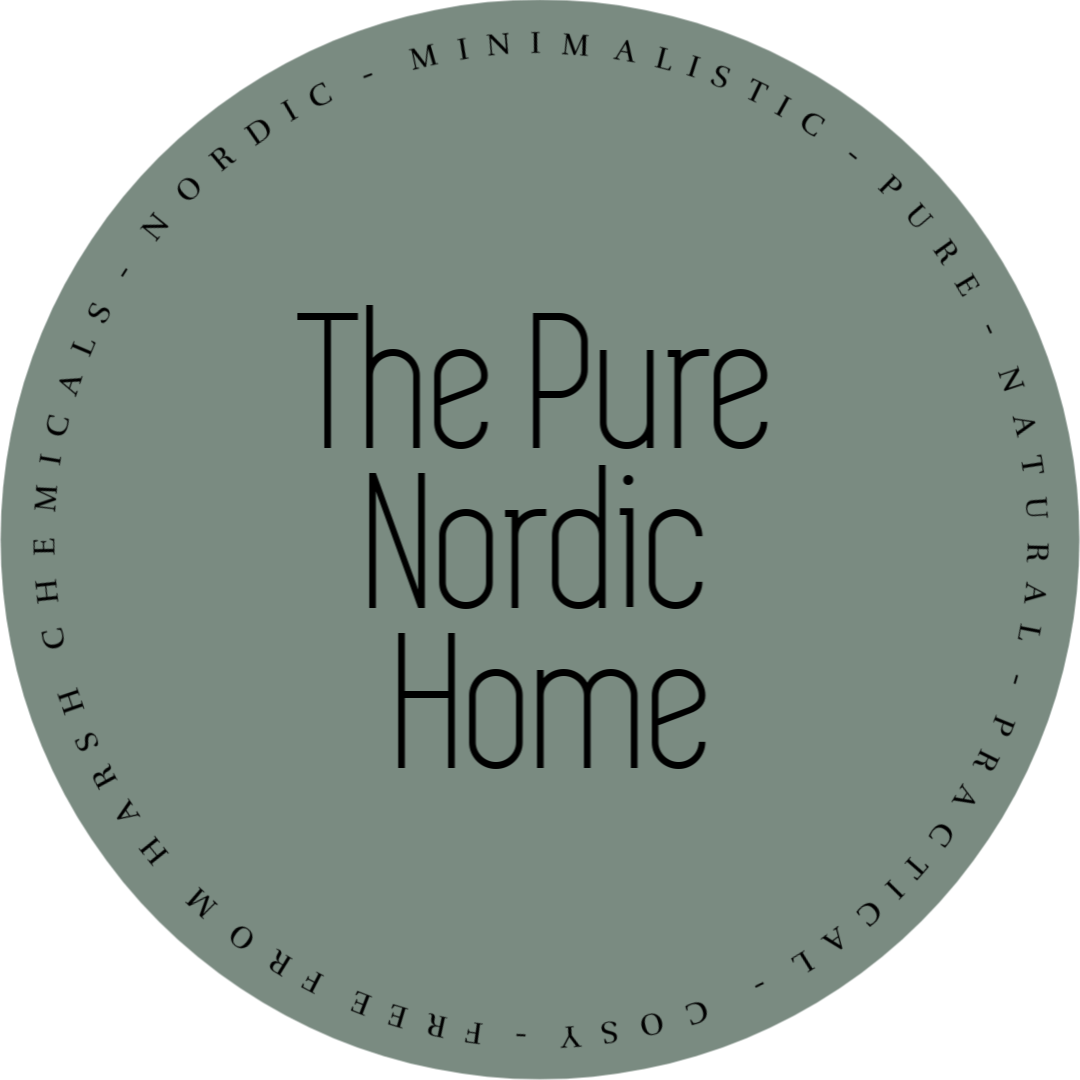






Lucie
This post come out at the right time for me as I am yet again, trying a new type of natural deodorant. I’ve tried th crystal, the powdered stuff, and now it’s an all natural stick. I think I just have to get over the fact that they won’t work exactly the same way as the conventional stuff. I will try the ACV spray and see if that helps… thanks for the tips!
admin
Hey Lucie, thanks for the comment. Would you mind sharing a bit more about what is not working? Still smelling or getting rashes perhaps? If smelling is an issue I have also heard many say that consuming or applying more magnesium topically does help with the smell. Good luck with the switch, hope it works this time!
Laura at Fairly Southern
Wow, this is a great comprehensive guide to natural deodorants! I have tried several times to make the switch and have really struggled, with everything from horribly painful lumps in my armpits to general smelliness. You are the second person who has mentioned underarm masks; I think I will have to try that the next time I give it a go!
admin
Thank you for the comment Laura 🙂 Yes, the post should cover most of it. Ahh not good to hear about the painful lumps, I really know what you mean, it’s very painful! Please let me know how it goes if you give the underarm mask a try ❤️
Rosie (GreenRosieLife)
Bookmarking this for reading again later – it’s an issue I struggle with so I need to try again!
admin
Hey Rosie, thanks for the comment! Good luck with the switch, hope you will be successful, please give it time.
Petro
Gudfinna….dear lord! I’ve been wanting to make this switch for some time. I would NEVER have thought this is what it entails. “Journey” is an understatement. Thanks for the wake-up call. Better get on that road asap!
admin
You are welcome Petro 🙂 Haha yes, there can be quite a bit of troubleshooting on the way of succeeding with the switch, hopefully it goes smoothly for you ❤️
Barbara Alfeo
Oh this is so helpful! I have been changing things like this since getting pregnant.
admin
Great to hear that Barbara 🙂 Yes, that is the most important time to be thinking about switches like this!
Christina Kamp
It’s so hard to give up some things, but deodorants are so dangerous, this is a great post with lots of great information!
admin
Thanks Christina 🙂
Diane Alkier
I am so Pinning this! It took me forever to find a natural deodorant that worked for me!
admin
Great! I know, it is not easy 🙂
admin
Great! I know, it can be hard. Thanks for reading Diane.
Vladka
I use coconut oil almost everywhere but I didn’t tried it as deodorant. I have never heard! It’s on my list. Thanks
admin
Great, hope it works!
Shannon
Very informative, great post! I switched to natural deodorant a couple years ago but I have noticed all brands don’t work the same. My husband gets rashes from baking soda ones. But the ACV is a great tip for detoxing!
admin
Thank you Shannon 🙂 I know the brands do vary a lot, I have tested quite many and they all have their pros and cons. Ahh, that’s a shame. I hope the ACV helps!
vintage house restaurant
Hello, I desire to subscribe for this weblog to get hottest updates, thus where can i do it please help out. http://www.Vintagehouserestaurant.com/
admin
There are a couple of opt-ins into the newsletters on the website – one on the front page, and one in this post about plastic infographic 🙂
Jackie
If making your own, what would you suggest in place of baking soda? I have an amazing recipe that works well, but the rash from the baking soda is awful
Anna
Many thanks the information is very enlightening and helpful. Hope it will work